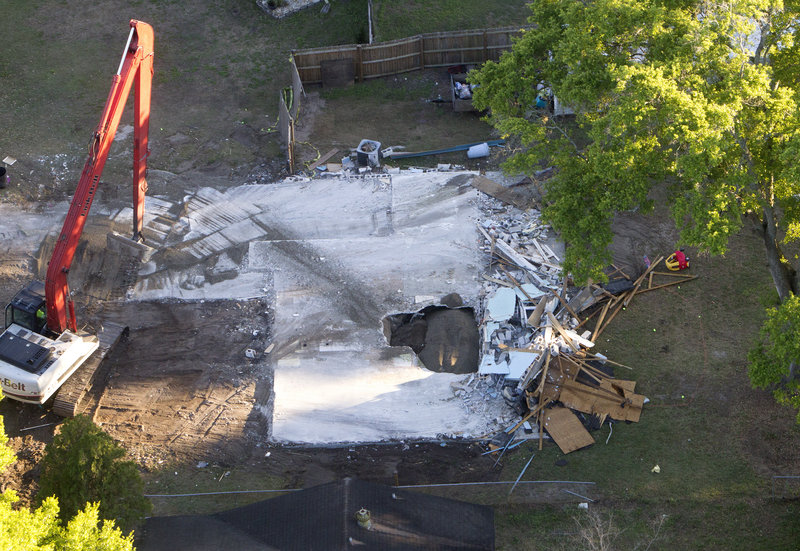SEFFNER, Fla. — As crews entombed a man who was swallowed by a sinkhole near Tampa, the earth opened up again just a few miles away. On Tuesday, in a neighboring county, officials investigated reports of a home cracking, perhaps due to another sinkhole.
Across Florida this time of year, it’s the start of what’s unofficially considered the “sinkhole season,” State Geologist Jonathan Arthur said. It coincides with the beginning of the state’s rainy season and usually lasts until the end of summer.
“Florida is famous for bugs, alligators, pythons, hurricanes and now sinkholes,” said Larry McKinnon, a Hillsborough sheriff’s office spokesman. “I think our salvation is that for most of the time, our weather is picture-perfect.”
But it’s also the weather – along with man-made factors – that exacerbate sinkholes, experts said.
Arthur said February is usually when the state is at its driest, but it’s also the start of the rainy season. Acidic rain can, over time, eat away the limestone and natural caverns that lie under much of the state, causing sinkholes. Both extremely dry weather and very wet weather can trigger sinkholes, he said.
“An extensive drought can cause soil and sediment over a cavity to be extremely dry and collapse,” said Arthur.
On the other hand, following Tropical Storm Debby in 2012, dozens of sinkholes formed in counties north of Tampa because of the rain.
In Hillsborough County, an area particularly susceptible to sinkholes, 37-year-old Jeff Bush was killed last week when a hole opened up underneath his bedroom. Engineering experts have said it is too dangerous to retrieve Bush’s body, so they demolished the home and filled the hole with gravel.
Hillsborough County is in a moderate drought, but engineers and county officials don’t know exactly why the sinkhole formed in Seffner, and said they will likely never know.
The county has had 1.56 inches of rainfall since Jan. 1; it usually averages about 5.41 inches, according to the National Weather Service.
In Pinellas County, about 30 miles away from Seffner, fire-rescue workers in Palm Harbor said they asked two people to evacuate a home after the residents reported “extensive cracking on the interior and exterior of the home.”
Arthur said he looked at 50 years of data and found that there is usually an uptick of reported sinkholes in February, with an increase until about July, when activity tapers off. December and January have typically low sinkhole activity.
Florida tracks naturally-occurring sinkholes and other ground collapses following a busted water main, development and groundwater pumping for crops.
In 2010, strawberry farmers in eastern Hillsborough County pumped so much water that more than 65 sinkholes opened in the area and wells went dry.
“When they take water out of the ground it’s like taking air out of a balloon,” said Bill Fernandez, a Florida sinkhole repair expert.Arthur added that moving dirt around for development can also trigger sinkholes. On Sunday in Largo, a failure in a pipe in a mall’s stormwater control system under the parking lot caused the ground to collapse.
“There are a lot of variables,” said Arthur. “Sinkholes are naturally occurring. Regardless of human activity they would occur.”
Send questions/comments to the editors.



Success. Please wait for the page to reload. If the page does not reload within 5 seconds, please refresh the page.
Enter your email and password to access comments.
Hi, to comment on stories you must . This profile is in addition to your subscription and website login.
Already have a commenting profile? .
Invalid username/password.
Please check your email to confirm and complete your registration.
Only subscribers are eligible to post comments. Please subscribe or login first for digital access. Here’s why.
Use the form below to reset your password. When you've submitted your account email, we will send an email with a reset code.